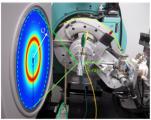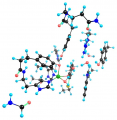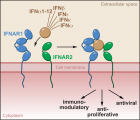Understanding the physical underpinnings of how proteins interact specifically with one another and not with the myriad other molecules that coexist in every cellular compartment is a major goal of molecular biology. The broad outlines of an answer were suggested by Linus Pauling in the 1940’s: the aggregate effect of numerous weak and nonspecific van der Waals, hydrogen-bonding, and electrostatic interactions underlie high specificity and affinity. Since Pauling’s days thousands of co-crystal structures have provided concrete examples for how molecular recognition is achieved in different biological contexts. Yet, the ultimate proof for understanding a natural phenomenon lies in recapitulating it; in the words of Thomas Edison, ‘until man duplicates a single blade of grass, Nature laughs at his so-called scientific knowledge’.
Approximately 1,700 scientists visit SSRL annually to conduct experiments in broad disciplines including life sciences, materials, environmental science, and accelerator physics. Science highlights featured here and in our monthly newsletter, Headlines, increase the visibility of user science as well as the important contribution of SSRL in facilitating basic and applied scientific research. Many of these scientific highlights have been included in reports to funding agencies and have been picked up by other media. Users are strongly encouraged to contact us when exciting results are about to be published. We can work with users and the SLAC Office of Communication to develop the story and to communicate user research findings to a much broader audience. Visit SSRL Publications for a list of the hundreds of SSRL-related scientific papers published annually. Contact us to add your most recent publications to this collection.
A new magnetic state called a quantum spin liquid has been observed by a large international team of investigators from ten institutions1, including a group using SSRL. When magnetic ions are located within a crystal lattice there are usually strong local magnetic and electric forces between them. At low temperatures such forces lead to a preferred alignment of the atomic moments – in ferromagnets such as iron for example, the atomic magnets are aligned parallel to each other while in anti-ferromagnets they are antiparallel. In other cases the atomic magnetics are aligned along crystallographic axis within the crystal. So quite generally when cooled sufficiently, the atomic moments develop a definite alignment.
The ability to design and control the activities of transition metal catalysts, which are scarce in nature and thus expensive, has been of great importance to the development of economical industrial and energy-saving processes. Over the years several methods have been suggested, especially for processes using platinum, which is the most active metal catalyst for many important reactions, including the reduction of oxygen in fuel cells.
Changing the electronic structure of a metal in order to “tune” its affinity to catalytic reaction intermediates is a key element in catalyst design. Tailor-made catalysts with a carefully adjusted ratio of two or more different alloy components are particularly needed in fuel cells, which could efficiently power electric vehicles – without the range limitations of current batteries. Both convert chemically stored energy into electricity, but in batteries this storage is limited to the electrode materials themselves, while fuel cells draw hydrogen or methanol from a tank and oxygen from air.
Dramatic improvements in energy storage devices are essential to meet the increasing need to move away from fossil fuels and toward clean, renewable energy. Rechargeable lithium-sulfur (Li-S) batteries hold great potential for high-performance energy storage systems because they have a high theoretical specific energy, low cost, and are eco-friendly; but a better understanding of how the battery functions is required to design improvements for higher efficiency and capacity.
Prostate cancer, the most common cancer in men, is often a localized, slow-growing cancer, which aids treatment and improves survival rates. However, highly aggressive, metastatic forms of the cancer occur frequently enough to make it the No. 2 cause of death in U.S. men. Part of the reason for this high mortality rate is the lack of effective drugs to fight these more aggressive cancers.
Nearly 400 years ago, the Swedish warship Vasa sank to its watery grave. In 287 BCE, a Roman warship with its bronze naval ram sank after battle to the bottom of the sea. And in 1545, the flagship of Henry VIII’s navy, the Mary Rose, sank outside of Portsmouth while maneuvering to engage the French fleet. Using SSRL Beam Line 4-3, a team of SSRL and University of Palermo researchers measured x-ray spectra of the sulfur inside wooden sections of the Roman ram, revealing the kinds of sulfur hidden within.
The continuous advancement of X-ray spectroscopic techniques allows us to probe the structure of biological machineries for smaller samples in more dilute concentrations and thus to ask tough scientific questions about problems that have not been possible in the past. Careful biochemical preparation and systematic analytical characterization resulted in galactose oxidase samples that could be interrogated by X-rays. This metalloenzyme contains a copper at its active site that is coordinated to a cross-linked tyrosine and cysteine ligand, which both are essential to convert alcohols and sugars to their oxidized aldehyde forms by oxygen molecule. The remarkable feature of this reaction that it is selective and does not results in formation of carboxylates (a form of vinegar).
However, the superconducting gap distributions in iron-based superconductors do not fall neatly into either of these two symmetries. Nodeless gap distributions, such as are associated with s-wave pairing symmetry have been directly observed in some members of the iron-based family of high-temperature superconductors, and the signatures of nodal superconducting gaps have been reported in others.
Cytokines are central to the innate immune system. Type I interferons (IFNs) are a kind of cytokine signaling protein that is important for cellular communication, regulating diverse cellular processes. Showing surprising economy, just one receptor is responsible for binding a variety of IFNs, each with differing functions.














